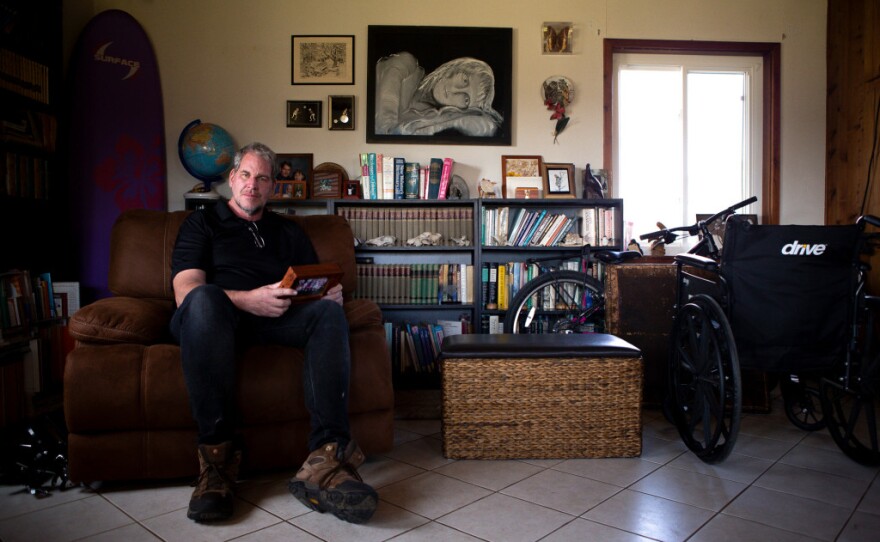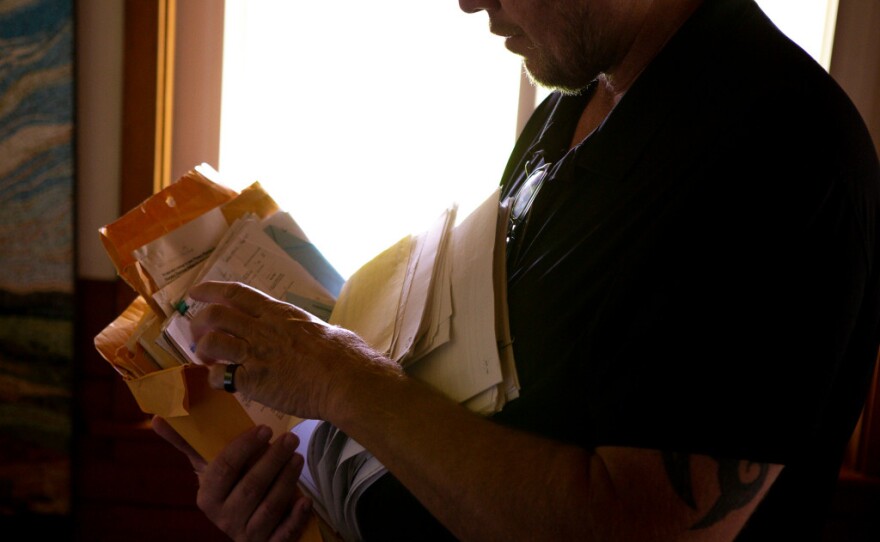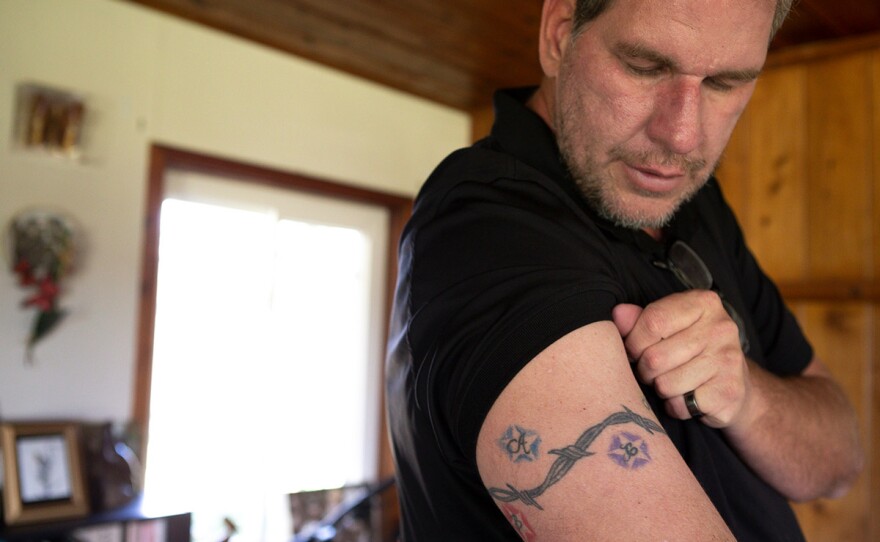When Andrew Simmons first started getting billed for his son’s stints in juvenile hall, he was shocked.
“I just thought that was crazy. I mean you’re going to arrest my kid and then you’re going to charge me for it?” Simmons said.
Simmons ended up owing nearly $14,000 to San Diego County, including $20 per day for his son’s 53 days in-home supervision and $31 per day for his more than 400 days in juvenile detention, according to a county audit of his account.

The county filed a lien on the Simmons’ house in 2016 and intercepted his $660 tax refund in 2017. Otherwise, Simmons, who has six adopted children, hasn’t chipped away at any of the debt. Although he and his wife have full-time jobs, he said they can’t afford to.
“You’re almost penalized for doing … the right thing” by adopting, Simmons said. “It’s kind of like we’ve done everything we can possibly do for these kids and it just comes at a huge price.”

California is the first state in the nation to ban the practice of charging parents for the cost of their children’s time in the juvenile justice system. But its new law, enacted in 2018, doesn’t require counties to forgive fees that parents were charged before 2018.
Most counties voluntarily cleared the parents’ old debt off the books. However, 22 counties are still pursuing debt that totals nearly $137 million as of Jan. 1, 2018, according to an October report from UC Berkeley’s Policy Advocacy Clinic.
As a result, tens of thousands of families across California still owe juvenile justice fees that the state has since abolished. Some families, like the Simmons, have had their tax refunds intercepted and liens placed on their houses. Others have had their wages garnished or their bank accounts emptied.
Five counties — San Diego, Orange, Riverside, Tulare and Stanislaus — have been collecting nearly all of these old fees, with close to 414,000 accounts outstanding.
“I WOULD REALLY HOPE THOSE COUNTIES WOULD STEP UP.”
-STATE SEN. HOLLY MITCHELL
Because families can have multiple accounts, it’s difficult to estimate the number of families or their average debt. But the nearly $14,000 that Simmons’ son accrued is fairly typical, according to Stephanie Campos-Bui, a supervising attorney at the Berkeley Policy Advocacy Clinic who co-authored the report.
Sen. Holly Mitchell, a Los Angeles Democrat who introduced the law to abolish juvenile fees, urges the rest of the counties to stop pursuing the old debt.
“Given the statewide and national trend recognizing the excessive harm those fines and fees impose on low-income, system-touched families, I would really hope those counties would step up,” Mitchell said.
For many counties, it comes down to money, said Darby Kernan, deputy executive director of the California State Association of Counties.
Operating juvenile halls is expensive. San Diego County spent $66.7 million in the 2017-2018 fiscal year to run its juvenile halls and camps, Orange County spent $64.6 million and Riverside County spent $38.9 million, according to a 2019 report by the California Board of State and Community Corrections.
“Counties are moving in this direction of not collecting past debt but there are definitely counties that have used these funds to fund their social workers, probation officers,” Kernan said.
San Diego County Board of Supervisors Chair Greg Cox said the funds are needed for “valuable services that help our youth.”
“These funds are legally collected by the county to pay for public safety services, including the cost of housing youth in detention and commitment facilities, as well as to offset a portion of the costs of legal representation,” Cox said.
The practice of charging parents for the administrative costs of their children’s incarceration has roots in 1970s and 1980s social policy, which suggested that parents would have more incentive to keep their children out of trouble if they were held liable for it.
“There was this myth that parents were dropping off their kids at juvenile detention facilities because they just couldn’t deal with them anymore, (that) they were using them essentially as a babysitting service,” Campos-Bui said.
As the state slashed funding across the board during the last recession, some counties began tacking on new juvenile fees. Alameda County increased the fees more than ten-fold in 2009. The fees for a typical family in Alameda ballooned from less than $250 to nearly $3,000, according to a 2016 report from the Policy Advocacy Clinic.
There was no uniform formula for how counties set the fees. A lack of state oversight combined with a decentralized juvenile justice system led some California counties to charge some of the nation’s highest fees, Campos-Bui said.
Parents were charged anything from $3.18 in Lake County to $40 in San Luis Obispo per day for stays in juvenile halls, according to a 2017 report from the Berkeley researchers. The daily cost of an electronic monitoring bracelet varied from $3.50 in Mono County to $30 in Yolo County. Many counties also charged for public defenders, probation supervision and drug testing. Meanwhile, San Francisco never charged any juvenile fees. Some counties forgave outstanding debt every few years, while others never did. Sacramento County continued to collect juvenile fees from as early as 1974.
In the last decade, attitudes toward charging parents shifted.
A 2017 study in a Pennsylvania county found that debt from a minor’s incarceration correlated with a greater likelihood of their committing another offense. And families of color were nearly twice as likely to have debt than white families. The same year, an analysis showed that black youth in California were committed to juvenile detention at a rate 7.3 times higher than white youth, causing some county officials to worry that the fees disproportionately burdened communities of color.
Los Angeles County led the pack by eliminating fees related to juvenile detention in 2009, followed by Santa Clara, Alameda and Contra Costa in 2016.
Mitchell introduced her bill to end juvenile fees in 2017 but she eliminated a provision to discard old fees amid concerns from counties about costs.
Most counties decided to stop going after old juvenile fee debt, discharging more than $237 million in debt, according to the 2019 Berkeley report, which is based on public records obtained from all 58 counties.
“When I read about SB 190, I was so excited. I’m like, this is it,” said Simmons. He was crushed when he learned the new law didn’t touch old debt. He called it “a raw deal.”
Mitchell said she considers the law a major success, but it’s troubling for her to hear from parents who feel overlooked.
“It was not my intention to leave them behind. As you negotiate a bill through the legislative process, it was the best I could deliver,” said Mitchell. She also has proposed a new law to abolish some fees in the adult system, which would make existing debt uncollectible.
Simmons and his wife have steady incomes from his food delivery business and her job in communications for the San Diego Zoo. But he said their finances have been “break-even,” as they’ve raised six adopted kids, all siblings.
On the one hand, Simmons said he understands the argument that taxpayers shouldn’t “have to pay for your inability to raise a kid.” But his son had inherited a lot of challenges, having spent his first nine years in the tumultuous home of a relative where he was exposed to abuse and drug use.
CalMatters could not get in contact with Simmons’ son to confirm what charges he was incarcerated for.
“Because of the children’s upbringing, it’s hard to change what they know already,” Simmons said, “Even with everything that (my son) did, (he) still has the potential to be a better person.”
Every morning, Felicitas wakes up at 2:30, careful not to disturb her son, who shares a room in a family member’s condo. She drives 20 minutes to a factory in Fullerton, where she shapes chocolate doughnuts, muffins and cookies while the rest of Orange County sleeps.
The work is tiresome, but she’s content. Earning $13.40 per hour and working about 35 hours per week, she can usually cover her monthly expenses.
But if she’s assigned more hours and her paycheck rises to more than $520 a week — full-time minimum-wage earnings — Orange County resumes garnishing her wages. In October, when she was working more hours, one of her paychecks was garnished, she said, although she didn’t have the pay stub to prove it. It’s the county’s latest strategy to get Felicitas to pay the $5,860.16 that she still owes from about a decade ago, according to her county bill. Her son told CalMatters that when he was 15, he spent a total of a year in juvenile hall, once for stealing a car and another time for a fight.
(CalMatters agreed to identify Felicitas by only her middle name to protect her son because his juvenile criminal records are sealed.)
At first, Felicitas paid what she could each month. A bill sent by the county in December shows that she paid more than $1,000. But after losing a job, she soon stopped sending payments. Other needs were more pressing.
“I don’t understand why they want to charge me that quantity if they know that I don’t have the resources to be able to pay them,” she said in Spanish.
Counties are required by state law to assess whether a person is able to pay before charging fees. Orange County Assistant Chief Probation Officer Bryan Prieto said that the county conducts an ability-to-pay analysis “in each and every case” and families can dispute their financial assessment in court.
“I THINK IT’S UNJUST AND UNFAIR THAT SHE WOULD HAVE TO PAY FOR SOMETHING I DID.”
-FELICITA’S SON
But Felicitas only recalls being told to sign papers that she didn’t understand.
This is common, according to Elizabeth Gonzalez, directing attorney at Public Law Center, an Orange County nonprofit that provides free legal services to low-income residents.
“Generally speaking in our experience, there isn’t really a conversation between the officer and the family about their ability to pay,” said Gonzalez, who has reviewed Felicitas’ debt.
Felicitas’ son, who works part-time while studying computer science at community college, promised his mom that he’ll repay her.
“I feel terrible about the fact that they’re taking her wages and not mine. It’s something I feel very guilty about,” he said. “I think it’s unjust and unfair that she would have to pay for something I did.”
Cases like Felicitas’ raise questions about whether it makes financial sense for counties to pursue debt from parents who are unable to pay, given that collection efforts are costly.
Orange County collects about $1.1 million in juvenile fees annually, Prieto said, adding that the probation department “considers its collection program to be very successful” and that the county’s collections of juvenile fees exceed the cost of its collection efforts. He did not provide concrete numbers, though.
Orange County Supervisor Don Wagner is not so sure. He has requested that the probation department analyze whether revenue from collections really offsets the costs. The results, he said, could lead him to introduce a measure to clear the debt.
“I am concerned that the most likely source of recovery of these funds is from people who are in fact working, who do own property, who are banking,” Wagner said. “Do I want to discourage jobs and property ownership and banking to keep collecting on these fees? The answer is maybe no.”
In the past two years, San Diego County has collected $3.6 million of the $58.8 million in juvenile fee debt that was on the books on Jan. 1, 2018, according to county Communications Director Michael Workman. For every dollar collected in 2019, it spent about 60 cents on collection efforts, Workman said.
Cox, from the San Diego County board, said in an email that he is “willing to consider a review this year of the collection of these funds and discuss it further with my colleagues.”
Riverside, the county with the third-highest outstanding debt, has collected just 3% of $15 million, said Riverside Superior Court Public Information Officer Marita Ford. The county did not provide an estimate of the cost of collection efforts.
A bill to be introduced soon by state Sen. Maria Elena Durazo, a Los Angeles Democrat, could wipe away all old juvenile fee debt.
Counties shouldn’t fund their programs “by collecting on the debt of very poor people,” Durazo said. “To turn around and to try to squeeze them when they have so little — squeeze them to try to get money which then is used to help poor people — sounds like a very crazy, crazy strategy.”

Simmons says he has no intention of voluntarily paying off the more than $13,000 he still owes San Diego County, especially given the economic sacrifices that he and his wife made to adopt six kids.
“I would do it all over again because I really believe that these kids are better off than if they’d stayed in the system,” Simmons said. “I would probably just maybe not tell the cops if my kid was home or not.”
He hopes that the county’s threat of garnishing wages remains just a threat, but he knows he might not see another tax refund for years.
“It will just be less money that we use towards college funds, or I don’t know, something,” Simmons said. “There’s always a bill to pay.”






